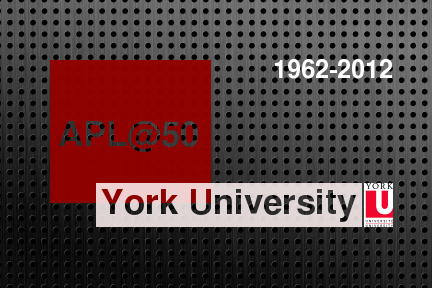|
APL@50
November 1, 2012
York University

Organized by: Department of Computer Science & Engineering
and York University Computer Museum.
Sponsored by: Faculty of Science & Engineering, York University, Toronto and by Toronto APL Special Interest Group.
Location: York University, Keele campus, Lassonde Building, Lecture Hall B
Directions: follow Location & Travel Info link from the main menu.
Time: 10 am -- 4 pm.

APL@50...
Department of Computer Science and Engineering, York University, is organizing a
special one day event to celebrate the 50th anniversary of the APL programming
language and the software engineering culture that the language has created. The
event will take place on November 1, 2012, at York University. It will consist of
lectures, demonstrations, exhibits, and a panel (see Event Program and
Exhibits and Demos for details).

A bit of APL history
In 1962, a Canadian computer scientist Kenneth Iverson published his influential book
A Programming Language starting a long and rich history of APL -- one of the
most innovative and influential early programming languages. The book described the
principles and applications of a symbolic language (a notation system) to be known as
"Iverson notation".
In 1965, the work of Iverson and his team of collaborators at IBM resulted in
the first implementation of APL. In 1968, IBM made the APL software publicly
available. And the rest, as the idiom goes, is history. In the 1970s, APL conferences,
meetings, publications and interest groups, as well as "I love APL" stickers and buttons,
T-shirts and songs, transformed the initial curiosity about the principles of APL
programming into an unprecedented cultural phenomenon. Every major computer manufacturer
was offering its own APL environment.
In 1979, Iverson received the ACM Turing Award--the highest distinction in
Computer science
For his pioneering effort in programming languages and mathematical
notation resulting in what the computing field now knows as APL, for his
contributions to the implementation of interactive systems, to educational
uses of APL, and to programming language theory and practice.
On June 11, 1998, Iverson received honorary degree of Doctor of Science from
York. In the citation read by Professor B. Drummond, the University Orator, it was
stressed that:
It is not only because York University was one of the first institutions outside
IBM to make use of APL that we are particularly proud to honour Kenneth Iverson
today. A creative inventor, pedagogical pioneer and breaker of disciplinary
boundaries, Dr. Iverson exemplifies our highest ambitions for our own faculty
and students.

APL now
Since the release of the first APL software by IBM, there have been very many
releases of APL products, too numerous to list. There were interpreters developed
by mainframe manufacturers (e.g. Burroughs, CDC, Data General, or IBM), by timeshare
services (e.g. I.P. Sharp SHARP APL) or Scientific Time Sharing Corporation (APL*PLUS)),
by microcomputer companies (e.g. Micro Computer Machines (MCM/APL)), even computer
hobbyists.
Other companies have been involved in developing APL software products and were
evolving APL into the next generation of programming languages (e.g. IBM's APL2,
Micro APL's APLX, Dyalog APL, Jsoftware's J, or Kx Systems' K).
APL meetings and conferences (e.g. APL2000 User Conference 2012) and dedicated
APL publications (e.g. Vector -- the journal of the British APL Association)
complete the current APL landscape.

APL at York
York University was not only one of the first institutions outside IBM to make use of APL
but also one of the first universities to implement its own dialect of APL called
York APL in the late 1960s (the York APL service was installed at the university
in June of 1969). The language and its interpreter, developed primarily by Gord Ramer,
a former assistant director of the York University Computer Center and one of the speakers
at APL@50, were used by several
North American and European universities and institutions. The language
was characterized as compact, self-contained, and system independent. The
expertise gained during the design of York APL was used for the development
of another APL language--APL/MCM--for the world's first personal computer powered
by a microprocessor.
APL was taught at York until late 1970s. The university was organizing and sponsoring APL
conferences, such as The Use of APL in Educational Institutions that took place in
1972. And, finally, York University Computer Museum has been involved in building one of
the most extensive APL historical collections.

APL@50 Location
Follow the Travel Info link.
|


